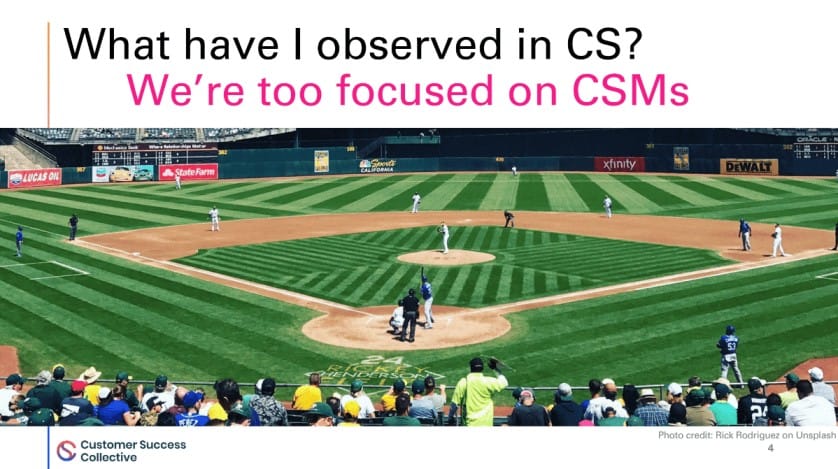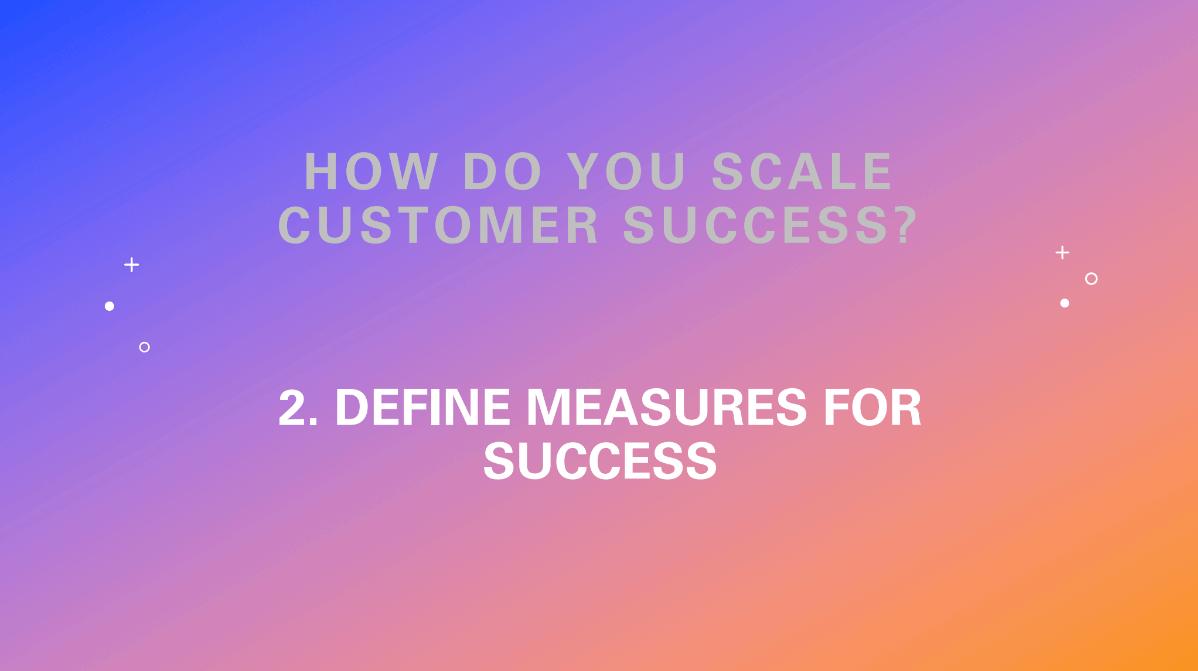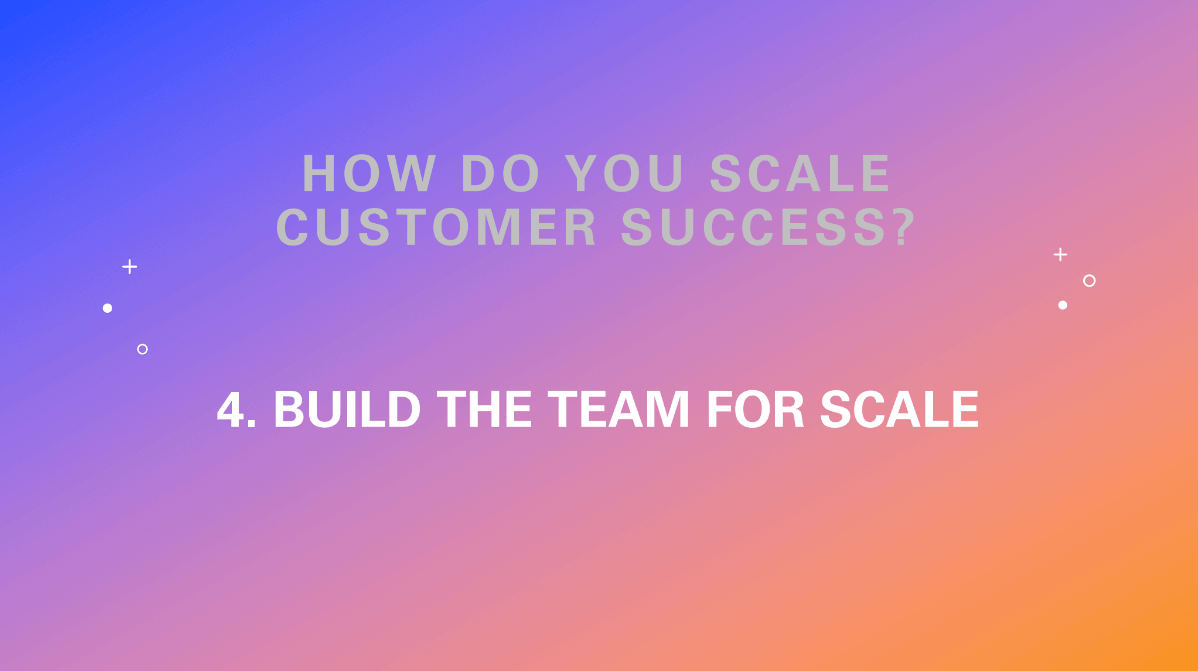This article is based on a presentation given by Doug at our Customer Success Festival in Austin, 2023.
Catch up on this presentation, and others, using our OnDemand service. For more exclusive content, visit your membership dashboard.
Scaling customer success is not just about expanding resources, but about strategically aligning every aspect of your approach. In my role as a leader in customer success, I've discovered that the key to thriving in this realm lies in a nuanced understanding of scale, collaboration, and innovation.
I’m Doug Norton, Head of Scaled Customer Success at Bill, and I’ve navigated the intricacies of customer success, focusing on not just broadening our reach, but also deepening our impact. This journey has taught me that true scaling is a blend of art and science, requiring a fine balance between technology, team dynamics, and customer engagement.
In this article, I’ll share my insights and experiences, offering a comprehensive guide on effectively scaling customer success, from building foundational partnerships to harnessing the power of technology and beyond.
Understanding the concept of scale
As someone deeply involved in customer success, I've often pondered the question: What does scaling really mean?
This concept can be divided into two primary areas. The first revolves around customer segmentation. Here, we consider our most valuable customers and the broader range – what I like to call the “long tail” of our customer base. The challenge lies in providing an exceptional experience across this entire spectrum.
The second area focuses on the digital experience. Our journey in the long tail teaches us valuable lessons. We experiment, learn, and then apply these insights across all customer interactions, ensuring a cohesive and effective digital experience.
Leading in customer success
My career began before the formal concept of customer success existed. I started a small business, quickly learning the harsh realities of cost-plus pricing. Seeking to enhance my business acumen, I transitioned into consulting. This phase of my career brought me invaluable experiences with diverse clients, ranging from Fortune 100 companies to those with modest revenues.
My focus was always on technology. I spent substantial time in data centers, collaborating with both hardware and software vendors. The emergence of cloud computing marked a significant phase in my career.
My consulting experience, primarily in sales strategy and go-to-market approaches, eventually led me to explore roles beyond consulting, where I could be directly responsible for outcomes rather than merely advising.
Working with companies like Equinix and Dell, I learned that the concept of scaling in these environments was unique. We dealt with a limited number of high-value customers making significant investments in data center services. This background was crucial in my recent transition to Bill, where scaling assumes a different context.
I don't claim to have all the answers for your businesses. Instead, I focus on a process-driven approach to problem-solving, drawing on my diverse experiences and the challenges I've navigated, including the dot-com bubble, the 2008 recession, and the recent global pandemic.
Today's world demands agility and speed, especially in customer success. While we strive to build automation and digital technologies, we must also remain adaptable to rapidly changing circumstances.
Rethinking customer success: Lessons from Moneyball (2011)
In my journey through customer success, one key realization has stood out: we often place too much emphasis on Customer Success Managers (CSMs).
This isn't a critique of CSMs themselves – they’re fantastic – but they are frequently burdened with an overwhelming array of tasks. Many CSMs feel like they're the catch-all solution for customer problems, plugging gaps wherever they appear.

Using a baseball analogy, if your organization doesn't have a budget like the New York Yankees, you can't rely solely on hiring more CSMs. You need a diverse set of tools and strategies. This reminds me of the book and 2011 movie, Moneyball, which I recently discussed with my team to illustrate the concept of scaling in customer success.
The story of the Oakland Athletics in the summer of 2002 is a powerful lesson. Following a series of setbacks and the loss of top players, the team, lacking the substantial budget of teams like the Yankees, faced a daunting challenge.
Traditional recruitment strategies focused on acquiring big hitters—the kind of players who sell tickets. But Billy Beane, the general manager, along with a Wall Street statistician, revolutionized their approach.
They argued that baseball was being misunderstood and mismanaged by focusing too much on home runs and not enough on getting players on base.
This story parallels our approach to customer success. Just like in baseball, it's not always about the big hitters or the home runs; it's about consistently getting on base.
We need to broaden our strategies beyond just relying on CSMs. It's about creating systems, processes, and tools that enable us to increase our “at-bats” - our opportunities to engage successfully with customers.
In essence, scaling in customer success is about rethinking our metrics and strategies. It's about understanding that success comes from consistent, smaller wins – getting on base – rather than always swinging for the fences.
This perspective helps us develop more sustainable, scalable customer success models that don't overburden our CSMs and instead leverage a more holistic approach to achieving our goals.
The power of partnership in scaling customer success
As I reflect on my experiences and the lessons I've learned in scaling customer success, one aspect stands out prominently: the importance of partnership beyond the Customer Success Representative (CSR).
The key to building a scaled program isn't just about hiring leaders or expanding the customer success team. It's fundamentally about forging effective partnerships.

At Bill, our approach to scaling customer success centers around partnerships, particularly with product marketing and support.
I often liken our team dynamic to that of a rowing team. In rowing, synchronization and uniform motion are essential. If one member rows out of sync, the entire team's direction and speed are compromised. This metaphor perfectly encapsulates how we operate; each department must work in harmony, contributing equally and effectively.

Since joining Bill, a major focus has been understanding and integrating with these departments. It's not about directing them to assist in customer success; it's a mutual relationship.
Customer success can significantly aid product teams by providing critical feedback, assisting marketing with customer stories and endorsements, and supporting the training needs, thereby reducing the demand on the support team.
Establishing these partnerships early has been crucial. It ensures that customer success doesn't become a catch-all department, shouldering all responsibilities. Instead, we share the load, enhancing the efficiency and effectiveness of each department.
An anecdote comes to mind: upon joining, I interviewed team members involved in our scaled efforts and inquired about the time they spent handling issues typically managed by support. Surprisingly, about 80% of their time was dedicated to such tasks. This raised questions about productivity and the real value of these activities.
While solving customer problems is important, it often doesn't translate immediately into opportunities for expansion, especially if the customer has just navigated a significant challenge.
The solution lies in establishing clear roles and responsibilities and fostering a collaborative environment where each department understands and appreciates the value and contribution of the others. This approach doesn't just prevent overlap and redundancy; it creates a well-oiled machine where each part supports the others, leading to a more robust and effective customer success strategy.
Through this collaborative model, we ensure that our customer success efforts are more strategic, targeted, and, most importantly, sustainable in the long term. It's about creating a balanced ecosystem within the organization where customer success is a shared responsibility and goal.
Defining the right measures for success
The second crucial element in scaling customer success is establishing appropriate measures for success. In my experience, finding the right balance between individual and organizational metrics is key to fostering both collaboration and accountability.

At the organizational level, we often see excellent collaboration. Team members are not solely focused on their personal targets, allowing for a more unified approach. However, this can sometimes lead to a lack of individual accountability.
Conversely, when we focus too much on individual metrics, it can lead to internal competition. Team members might prioritize their own goals over team or organizational objectives, which is not conducive to a collaborative environment.
Balancing inputs and outputs
Another challenge is distinguishing between inputs (what we can control) and outputs (the results or consequences of our actions). Inputs are within our team members' control, providing a sense of security and clarity. Outputs, however, are often the primary focus of executives, as they directly impact organizational value.

To bridge this gap, we've been experimenting with a hybrid approach to performance management and compensation.
We recognize and manage performance at the individual input level, acknowledging those who are pulling their weight and contributing effectively. However, we tie compensation more closely to the outcomes - not just in terms of value drivers but also in fostering collaboration.
The impact of this approach
This strategy has produced remarkable results. Within weeks of implementation, I've witnessed a transformation in team dynamics.
Team members have approached me during one-on-ones, expressing their amazement at the unprecedented level of collaboration. The usual tension associated with asking for help has dissipated, paving the way for more collective problem-solving and idea-sharing within the organization.
By aligning individual efforts with organizational goals and fostering a culture where collaboration is as valued as individual contributions, we've created an environment where everyone feels empowered and responsible for our collective success. This balance is crucial for scaling customer success effectively and sustainably.
Gaining leverage with technology in customer success
The third key aspect in scaling customer success is leveraging technology, a vital component of our digital world. Before delving into this, it's important to note that the first two steps I mentioned earlier are about laying the groundwork. We've engaged in conversations and started shaping our metrics.
Now, it's time to start building.

Adopting a digital-first or tech-first mindset is crucial. Our goal is to maximize what we can achieve with technology, particularly in mapping out the customer journey. This journey can be broken down into three key phases: activation, expansion, and retention.
Each phase involves numerous touchpoints with customers, and it's vital to understand that no single technology solution can cater to every need. Customers have diverse preferences, and it's our job to accommodate these varying tastes through different content formats, communication methods, and data-driven outreach.

At Bill, with over 400,000 customers, one-on-one interactions just aren't feasible.
We leverage data science to understand our customer personas, allowing us to craft personalized messages at scale. This approach ensures that each customer feels valued and understood, despite the vast number of clients we manage.
Implementing automation is a gradual process. I often relate it to a philosophy we have at home with our six children: the "touch it once" mindset.
This concept is about efficiency – do something thoroughly and correctly the first time to avoid unnecessary repetition. In the context of our work, automation doesn't happen overnight. It starts with small steps, like writing a manual email and then turning it into a template. Eventually, these templates can be integrated into tools like Gainsight, streamlining processes across various teams.
It's important to understand that you don't have to implement everything at once. Scaling and automating customer success is a journey.
You try different approaches, learn from each experience, and gradually build more efficient systems. Just like teaching our children to be efficient with their chores, we learn to make our work processes more efficient, one step at a time.
Leveraging technology in customer success is about more than just adopting new tools; it's about embracing a mindset that seeks to continually refine and improve how we interact with and serve our customers.
This approach not only enhances efficiency but also ensures that our customers receive personalized, high-quality experiences at every touchpoint.
Building the team for scale
The fourth critical element in our journey of scaling customer success is building a team equipped for scale. Here's where our focus on CSMs really comes into play.

Upon joining my current organization, I quickly realized that traditional approaches to managing customer accounts wouldn't work at scale.
With over 10,000 customers per CSM, conventional one-on-one interactions are not feasible. Therefore, we shifted our focus from managing territories to defining specific roles within programs. This change was challenging for the team initially, accustomed to managing smaller, more defined account lists.
Our strategy involves differentiating activities based on the customer's stage in their journey with us. For instance, starting a customer in FinTech involves connecting basic accounting systems and bank accounts.
Ramping up a customer, however, is more about introducing them to new experiences, like using a corporate charge card via a mobile app. Then, there's advisory work for customers who have started but aren't fully leveraging our platform's value, and different strategies for customers ready for expansion.

We also focus on resolution roles, identifying and addressing hurdles customers encounter in using our product. This approach is more about creating and managing programs rather than focusing on individual customer interactions.
Pooling is another essential aspect. While some team members specialize in specific areas, we encourage flexibility and collaboration across different segments. This approach is facilitated by measuring team performance based on collective outcomes, fostering a spirit of cooperation and mutual support.
A key insight I gleaned from the book "Atomic Habits" involves the story of a photography professor, Jerry Uelsmann. He divided his class into two groups: one graded on the quality of a single photo and the other on the quantity of photos produced.
Interestingly, the quantity group produced better-quality photos due to their constant practice and experimentation.
This story parallels our approach to scaling customer success. Rather than spending extensive time planning and executing a perfect strategy, we focus on experimentation and incremental improvements. It's about starting with small, manageable tasks, like crafting a good email, and gradually evolving these into templates and automated processes.
Building a team for scale in customer success is about embracing a journey of continuous improvement. It involves redefining roles, encouraging collaboration, and adopting a mindset of learning through doing.
By focusing on these elements, we can effectively manage and engage with a large customer base, providing high-quality experiences without overburdening our team.
Being impatient for results
The fifth and crucial element of my approach in scaling customer success is a concept I like to call 'being impatient for results'. This ties back to the notion of progressive experimentation and improvement, a principle I've applied in my personal life as well as professionally.

My journey into marathon running serves as a perfect analogy for this approach.
A few years ago, I set out to run a marathon, a feat I had never attempted before. Rather than aiming for a prestigious race like the Boston Marathon right off the bat, I started with a more manageable goal: completing a half marathon. My initial objective was simply to finish the race, setting a foundational milestone for myself.
In my second marathon, which was a local trail run, I managed to get on the podium. While it wasn't a high-stakes race and most participants were there for fun, it represented a step up from my first race.
Gradually, I've participated in several marathons, improving my times with each race. Though I'm not yet ready for the Boston Marathon, it remains an aspirational goal.
Applying this approach to customer success programs
This journey in marathon running mirrors how we should approach our customer success programs. Often, we are deeply focused on strategic, long-term growth, which is undoubtedly important.
However, it's equally crucial to identify and capitalize on quick wins - opportunities that allow us to experiment and incrementally move towards our larger strategic goals.
Just like how I gradually improved my marathon times, in customer success, we should be eager to see results and make progress, even if it's incremental. This mindset encourages continuous experimentation, learning, and adaptation. It helps us to keep evolving our strategies, ensuring they are as effective and efficient as possible.
Quick wins are not just about immediate gratification; they are about learning, adapting, and continually pushing toward larger objectives. They provide valuable insights, build momentum, and keep the team motivated and engaged.
'Being impatient for results' is about balancing the pursuit of long-term strategic goals with the recognition and exploitation of immediate opportunities for improvement and growth. It's about being agile, responsive, and always looking for ways to enhance our processes, methods, and outcomes in customer success.
Defining strategy and engaging the customer community
Let's circle back to the concept of strategy. I often define strategy with two fundamental questions: "Where are you going to play?" and "How are you going to win?". These questions have guided our approach in scaling customer success, especially in a scaled environment.
Understanding the strategy
The first two points I discussed — partnerships and aligning on metrics — are about defining where we're going to play. This involves understanding our playing field and establishing clear goals and measures.
Points three, four, and five — leveraging technology, building the team for scale, and being impatient for results — represent how we're going to win. We win by harnessing technology, strategically setting up our team with the right roles and motivations, and taking swift, decisive action. It's about building our long-term strategy in incremental, manageable steps.

Engaging the customer community
As a bonus point, I want to emphasize the importance of engaging with our customer community. This aspect has been incredibly enlightening in my journey through the world of customer success. Interacting with customers is a responsibility I don't take lightly.
Our customers are not just betting on our services; in many cases, they're staking their businesses and even their careers on our ability to deliver. Their success is intrinsically linked to ours.
This relationship with our customers is not just an opportunity; it's also a formidable challenge due to the sheer scale and impact of what we undertake.
Engaging the customer community, therefore, becomes a powerful tool in scaling our efforts. When more people are involved in the conversation, when we truly listen and respond to our customers' needs, the potential for success multiplies.
Final thoughts
Looking forward, I'm excited to delve deeper into this aspect of customer engagement. The journey of scaling customer success is ongoing, and the power of a collaborative customer community is an exciting frontier that I'm eager to explore further.
Scaling customer success is about understanding where to focus our efforts, leveraging technology, building a capable and motivated team, taking swift action, and deeply engaging with our customer community.
This holistic approach not only ensures our success but also fosters a strong, collaborative relationship with our customers, leading to mutual growth and success.



 Follow us on LinkedIn
Follow us on LinkedIn



